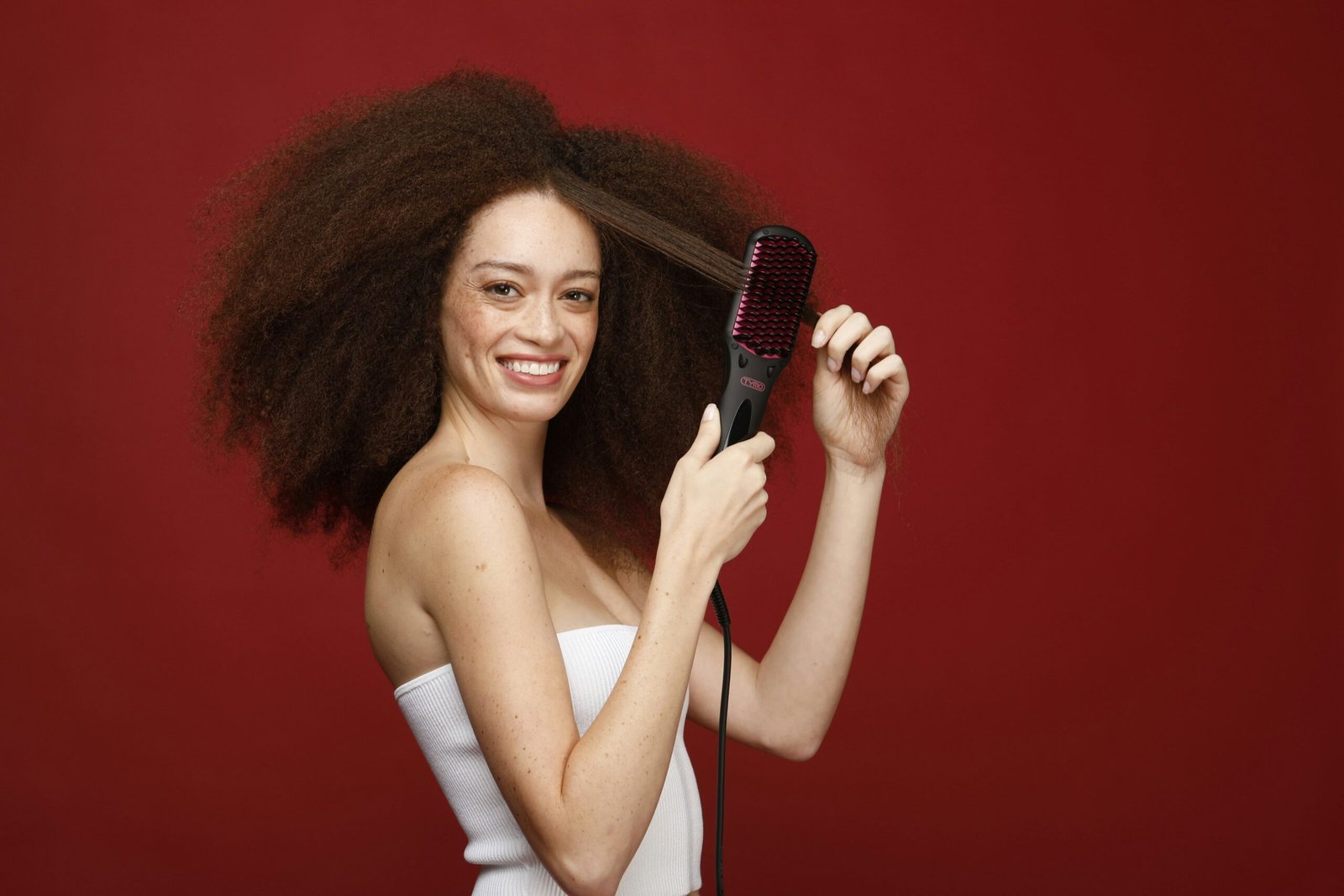The Ultimate Guide to Hair Brushes: Choosing the Right One for Your Hair Type
Hair brushes are an essential tool in the realm of haircare, playing a significant role in maintaining hair health and achieving desired styling outcomes. Whether you’re aiming for sleek and smooth locks or voluminous waves, the right brush can make all the difference. A well-chosen hair brush not only helps in detangling and managing hair but also distributes natural oils from the scalp, promoting overall hair health and shine.
However, not all hair brushes are created equal. Different hair types—be it straight, wavy, curly, or coily—require specific brushes to cater to their unique needs. For instance, a brush that’s perfect for fine, straight hair might not work well for thick, curly hair, and vice versa. Using the wrong brush can lead to issues such as breakage, frizz, and an overall lackluster appearance. Therefore, understanding which brush suits your hair type is crucial for optimal results.
In this comprehensive guide, we will explore the various types of hair brushes available, each designed to address specific haircare requirements. From paddle brushes to round brushes, and from natural bristle brushes to synthetic ones, we’ll delve into the functions and benefits of each type. By the end of this guide, you’ll be equipped with the knowledge needed to select the ideal brush for your hair type, ensuring you achieve the best possible outcomes in both hair health and styling.
So, whether you are looking to enhance your daily haircare routine or find the perfect brush to complement your hair type, this guide will provide you with the essential information to make an informed decision. Let’s embark on this journey to discover the ultimate hair brush for your unique hair needs.
Understanding Your Hair Type
Knowing your hair type is essential for selecting the right haircare products and tools, including your hair brush. Hair types are generally categorized into four main types: straight, wavy, curly, and coily. Each type has unique characteristics that determine the best haircare practices and tools for maintenance.
Straight hair, often classified as Type 1, tends to be smooth and shiny due to the way light reflects off the cuticle. It can range from fine to coarse in texture. The primary challenge for straight hair is its tendency to become oily and flat, which can make it difficult to style and maintain volume.
Wavy hair, or Type 2, falls between straight and curly hair. It usually has an S-shaped pattern and can vary from fine to coarse. Wavy hair often struggles with frizz and can lack definition without the right haircare routine. It requires a balance of moisture and control to maintain its natural wave pattern.
Curly hair, known as Type 3, forms distinct ringlets or spirals. This hair type is prone to dryness because the natural oils from the scalp have a harder time traveling down the hair shaft. Curly hair benefits from moisturizing and defining products to enhance its natural curl pattern and reduce frizz.
Coily hair, or Type 4, has the tightest curl pattern and ranges from very tight curls to zigzag patterns. This hair type is the most fragile and prone to breakage, requiring careful handling and ample moisture. Coily hair often needs intensive conditioning to keep it healthy and manageable.
Understanding your hair type enables you to select the most suitable hair brush that addresses your specific needs. For instance, straight hair may benefit from a paddle brush to add volume, while curly and coily hair types might require a wide-tooth comb or a brush specifically designed to detangle without causing breakage.
Types of Hair Brushes
When it comes to haircare, selecting the right hair brush is essential for maintaining the health and appearance of your hair. With an array of options available on the market, understanding the unique features and uses of each type can help you make an informed choice. Below, we explore some of the most popular types of hair brushes and their specific applications.
Paddle Brushes: Known for their broad, flat surface, paddle brushes are ideal for detangling and smoothing hair. They are particularly effective for those with long or thick hair, as the wide base covers more surface area, reducing styling time. These brushes often come with either plastic or natural bristles, and they work well for creating sleek, straight styles.
Round Brushes: Round brushes are a go-to for adding volume and creating curls or waves. They come in various sizes, with smaller barrels ideal for short hair and tighter curls, while larger barrels are perfect for longer hair and looser waves. The vented design of many round brushes allows for better airflow, making them excellent for blow-drying and achieving a bouncy, voluminous look.
Vented Brushes: Vented brushes feature openings in the base that allow air to flow through, speeding up the drying process. These brushes are great for quick styling and minimizing heat damage from blow dryers. They are versatile and can be used to add volume or smooth out the hair, making them a valuable addition to any haircare routine.
Detangling Brushes: Designed to gently work through knots and tangles, detangling brushes are a must-have for anyone prone to hair snarls. They often have flexible bristles that glide through the hair without causing breakage, making them suitable for all hair types, including curly and coily textures. These brushes can be used on both wet and dry hair, ensuring a pain-free detangling experience.
Boar Bristle Brushes: Boar bristle brushes are renowned for their ability to distribute natural oils from the scalp throughout the hair, promoting shine and reducing frizz. They are gentle on the hair and scalp, making them an excellent choice for daily use. These brushes work well for fine to medium hair types and are particularly beneficial for those looking to enhance their hair’s natural luster.
By understanding the distinct characteristics and benefits of these various hair brushes, you can select the right tool to complement your haircare routine and achieve your desired style with ease.
Choosing the Right Brush for Straight Hair
When it comes to maintaining the sleek and smooth appearance of straight hair, selecting the right hairbrush is crucial. Straight hair benefits greatly from brushes that can enhance its natural shine and reduce frizz. Two of the most recommended types of brushes for straight hair are paddle brushes and boar bristle brushes.
Paddle brushes are an excellent choice for straight hair due to their wide, flat surfaces that can cover more area at once. This makes detangling a breeze and helps in distributing natural oils from the scalp down the length of the hair. When using a paddle brush, it is advisable to start from the ends of your hair and work your way up to minimize breakage and avoid unnecessary stress on the hair shaft.
Boar bristle brushes, on the other hand, are known for their ability to smooth and add shine to straight hair. The natural bristles help to evenly distribute the scalp’s natural oils, providing a natural conditioning treatment and resulting in a glossy finish. For best results, use the boar bristle brush on dry hair. Begin brushing from the scalp to stimulate blood flow and encourage healthy hair growth, then work your way down to the tips to ensure even distribution of oils.
To maintain the sleek look of straight hair, it is important to incorporate a few tips when using these brushes. Always ensure that your hair is dry before brushing, as brushing wet hair can lead to breakage. Additionally, clean your brushes regularly to remove hair and product buildup, ensuring they remain effective and hygienic. For daily maintenance, gently brush your hair in sections, focusing on smoothing the outer layers and detangling any knots.
By choosing the right hairbrush and using it effectively, you can enhance the natural beauty of your straight hair, keeping it smooth, shiny, and healthy.
Choosing the Right Brush for Wavy Hair
When it comes to wavy hair, selecting the appropriate hairbrush can make a significant difference in maintaining the natural wave pattern while enhancing volume and reducing frizz. Wavy hair, characterized by its unique texture, requires a brush that can detangle without causing damage and accentuate its natural beauty. Two types of brushes stand out for wavy hair: round brushes and vented brushes.
Round brushes are particularly effective for wavy hair. Their cylindrical shape allows for better control and the creation of volume. When used with a blow dryer, a round brush can help to shape and define waves, adding a polished finish. Opt for a round brush with natural bristles; these bristles are gentle on hair and can help distribute the scalp’s natural oils, reducing frizz and adding shine.
Vented brushes are another excellent option for wavy hair. These brushes have gaps or holes that allow air to pass through, making them ideal for use with a blow dryer. The design of vented brushes helps to speed up drying time while minimizing heat damage. Additionally, the open structure of the brush helps to preserve the natural wave pattern, ensuring that the waves remain intact and voluminous.
When brushing wavy hair, technique is just as important as the brush itself. To avoid disrupting the natural wave pattern, it is advisable to brush wavy hair when it is damp rather than dry. Start at the ends and work your way up to the roots, gently detangling any knots. Using a wide-tooth comb initially can also help to remove tangles without creating frizz. For added definition, scrunch the hair with a microfiber towel after brushing to enhance the waves.
By choosing the right brush and employing proper brushing techniques, individuals with wavy hair can achieve a look that is both natural and refined. The right tools and methods can enhance the inherent beauty of wavy hair, making it easier to manage and style while maintaining its unique texture.
Choosing the Right Brush for Curly Hair
When it comes to curly hair, selecting the appropriate brush is pivotal to maintaining its health and definition. Curly hair is prone to tangling and breakage, making it essential to use tools that are gentle and effective. Two of the most beneficial tools for curly hair are detangling brushes and wide-tooth combs. These tools are designed to work through knots without causing unnecessary stress to the hair strands.
Detangling brushes are specifically crafted to glide through hair smoothly, reducing the risk of breakage. These brushes usually have flexible bristles that can move with the hair, making detangling a less painful and more efficient process. Using a detangling brush on wet hair, preferably with a leave-in conditioner, can help in minimizing friction and enhancing the detangling process.
Wide-tooth combs are another excellent option for curly hair. The wide spacing between the teeth allows the comb to work through the curls without disrupting their natural shape. This type of comb is particularly useful for detangling wet hair in the shower. Applying a generous amount of conditioner before using a wide-tooth comb can also aid in managing tangles more effectively.
When detangling curly hair, it is crucial to start from the ends and gradually work your way up to the roots. This technique helps in gently removing knots and prevents further tangling. It’s also beneficial to section the hair into smaller parts to ensure that each section is thoroughly detangled.
Maintaining the natural shape of curly hair involves more than just selecting the right brush. It is also important to avoid over-brushing, which can lead to frizz and loss of curl definition. Instead, focus on detangling and styling when the hair is damp. Additionally, incorporating moisturizing haircare products into your routine can help keep your curls hydrated and defined.
Overall, using detangling brushes and wide-tooth combs, along with proper detangling techniques and haircare products, can significantly improve the health and appearance of curly hair, ensuring that your curls remain vibrant and well-defined.
Choosing the Right Brush for Coily Hair
When it comes to caring for coily hair, selecting the appropriate brush is crucial to maintaining its health and texture. Coily hair, characterized by tight curls and kinks, requires a gentler approach to detangling and styling. The best brushes for coily hair are detangling brushes and wide-tooth combs. These tools are designed to minimize breakage and ease the process of detangling knots.
Detangling brushes, such as those with flexible bristles, are highly recommended. These brushes are specifically engineered to glide through coily hair without causing excessive tension, which can lead to breakage. The flexible bristles adjust to the curls, allowing for a smoother detangling experience. Additionally, using a wide-tooth comb can be beneficial as it helps to gently separate the strands without disrupting the natural curl pattern.
To brush coily hair effectively, it is essential to start with damp hair. Applying a leave-in conditioner or a detangling spray can provide extra slip, making the detangling process more manageable. Begin by sectioning the hair into manageable parts. This not only makes the task less daunting but also ensures that each section is thoroughly detangled.
Starting from the ends, gently work your way up to the roots, using short, gentle strokes. This technique helps to gradually remove tangles without causing unnecessary stress on the hair. It is crucial to be patient and avoid yanking or pulling, which can lead to breakage and damage to the hair shaft.
Maintaining the texture of coily hair involves regular moisturizing and minimal manipulation. Limiting the frequency of brushing and opting for styles that require less combing can help preserve the integrity of the curls. Regular deep conditioning treatments and protective styles are also beneficial in maintaining healthy, coily hair.
In summary, choosing the right brush for coily hair involves selecting detangling brushes and wide-tooth combs, practicing gentle brushing techniques, and maintaining the hair’s natural moisture and texture. By following these guidelines, you can ensure that your coily hair remains healthy and beautifully defined.
Maintenance and Care of Hair Brushes
Proper maintenance and care of hair brushes are paramount to extending their lifespan and ensuring they function effectively. Regular cleaning is essential to prevent the buildup of hair, oil, and product residue that can compromise both the brush’s performance and your scalp’s health. Here are some steps and tips to help you maintain your hair brushes.
Firstly, it is vital to remove hair from the brush after each use. This can be done using a comb, a specialized brush cleaner, or even your fingers. By doing this regularly, you prevent tangles and buildup that can make the brush less effective over time.
For a deeper clean, you should wash your hair brushes at least once a month. Begin by filling a basin with warm water and a few drops of mild shampoo or a gentle soap. Submerge the brush and gently scrub the bristles with an old toothbrush or a dedicated cleaning tool. Pay close attention to the base of the bristles where buildup is most likely to occur. Rinse thoroughly with clean water to remove any soap residue.
Allow the brush to air dry completely before using it again. Place it bristle-side down on a clean towel to avoid water from seeping into the handle, which could cause damage. This drying method not only aids in maintaining the brush’s structure but also helps prevent the growth of mold and bacteria.
It’s also important to recognize when it’s time to replace your hair brush. Signs that a brush needs replacing include missing or bent bristles, a cracked handle, or the inability to clean it effectively anymore. Using an old or damaged brush can result in poor haircare performance and even scalp irritation.
Maintaining the cleanliness and condition of your hair brushes is crucial for both your hair’s health and the brush’s longevity. Regular cleaning, proper drying, and timely replacement will ensure that your haircare routine remains effective and hygienic, contributing to healthier hair and scalp overall.
Conclusion and Final Tips
Throughout this comprehensive guide, we’ve explored the fundamental aspects of selecting the right hair brush tailored to your specific hair type. Understanding your hair’s unique characteristics—be it fine, thick, curly, or straight—is crucial in making an informed decision. The right brush not only enhances the appearance of your hair but also promotes its overall health by minimizing breakage and ensuring even distribution of natural oils.
Choosing the correct hair brush involves considering the material, bristle type, and shape that best aligns with your haircare needs. For instance, fine hair benefits from soft bristles that prevent damage, while thick hair requires sturdier options to detangle effectively. Curly hair thrives with wide-tooth combs or brushes designed to maintain curl patterns, whereas straight hair might find paddle brushes most effective for smooth styling.
Here are some final tips to keep in mind when selecting and using hair brushes:
- Experiment: Don’t hesitate to try different brushes to find the one that best suits your hair type and styling preferences.
- Maintenance: Regularly clean your brushes to remove hair, oils, and product buildup, which can impact their performance and hygiene.
- Gentle Techniques: Always brush your hair gently to avoid unnecessary tugging and breakage. Start from the ends and work your way up to the roots.
- Functional Variety: Invest in a variety of brushes for different purposes—detangling, styling, and smoothing—to ensure comprehensive haircare.
- Quality Over Quantity: High-quality brushes might be an investment, but they often provide better results and longevity.
Ultimately, the right hair brush can make a significant difference in your haircare routine. By understanding and considering your hair’s specific needs, you can achieve the best possible results and maintain healthy, beautiful hair. Happy brushing!
Share this content:




 Italiano
Italiano English
English Español
Español